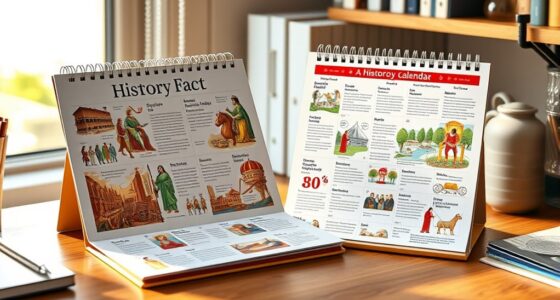If you’re looking for inspiring space exploration biographies, I recommend starting with titles like *Shoot for the Moon*, which captures the daring spirit of Apollo 11, and *First Man*, offering an intimate view of Neil Armstrong’s journey. *Endurance* and *Spaceman* showcase perseverance from astronauts Scott Kelly and Mike Massimino. Books like *Failure Is Not an Option* and *An Astronaut’s Guide to Life* blend leadership lessons with space stories. Keep exploring, and you’ll uncover stories that ignite curiosity and passion for the cosmos.
Key Takeaways
- Highlight biographies of pioneering astronauts like Neil Armstrong and Mike Massimino that showcase perseverance and innovation.
- Include stories emphasizing teamwork, leadership, and resilience to inspire future astronomers and space explorers.
- Focus on narratives blending personal vulnerability with technical achievements to motivate upcoming generations.
- Select biographies that provide both historical context and detailed insights into space missions for a comprehensive understanding.
- Prioritize books authored by credible authors with engaging storytelling, making complex space topics accessible and inspiring.
Shoot for the Moon: The Space Race and the Extraordinary Voyage of Apollo 11
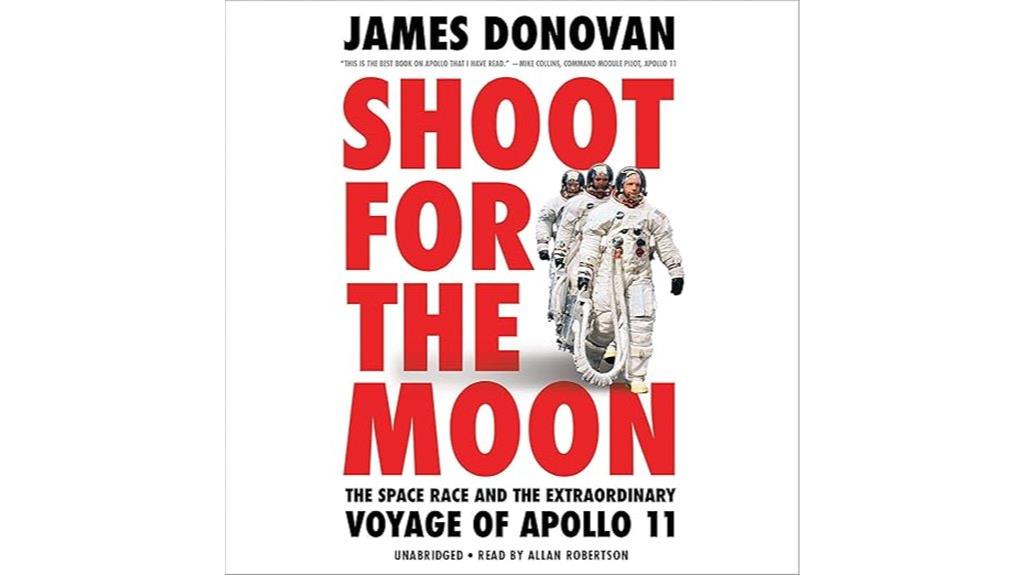
If you’re passionate about understanding the human story behind space exploration, “Shoot for the Moon” is an ideal pick. I found Donovan’s narrative enthralling, blending technical details with personal insights to create a vivid picture of the Apollo 11 mission. The book highlights the fierce rivalry with the Soviets, the groundbreaking achievements, and the dedication of the astronauts and engineers. It’s more than just a history book; it’s a story of perseverance, teamwork, and human ingenuity. Donovan’s storytelling made complex moments accessible and emotional, leaving me inspired by the audacity and spirit of those who dared to reach the Moon.
Best For: space enthusiasts and readers interested in the human stories and technical challenges behind the Apollo 11 moon landing.
Pros:
- Engaging and vivid storytelling that makes complex space history accessible and emotional
- Detailed insights into the technical achievements, personal sacrifices, and key personalities of the mission
- Provides a comprehensive overview of the space race, emphasizing American ingenuity and teamwork
Cons:
- Some readers may find the narrative somewhat reverent and lacking critical coverage of post-Apollo space developments
- Brief coverage of the later space programs and the long-term impact on space exploration
- Limited exploration of the personal lives of key individuals beyond the mission itself
Endurance: A Year in Space, a Lifetime of Discovery
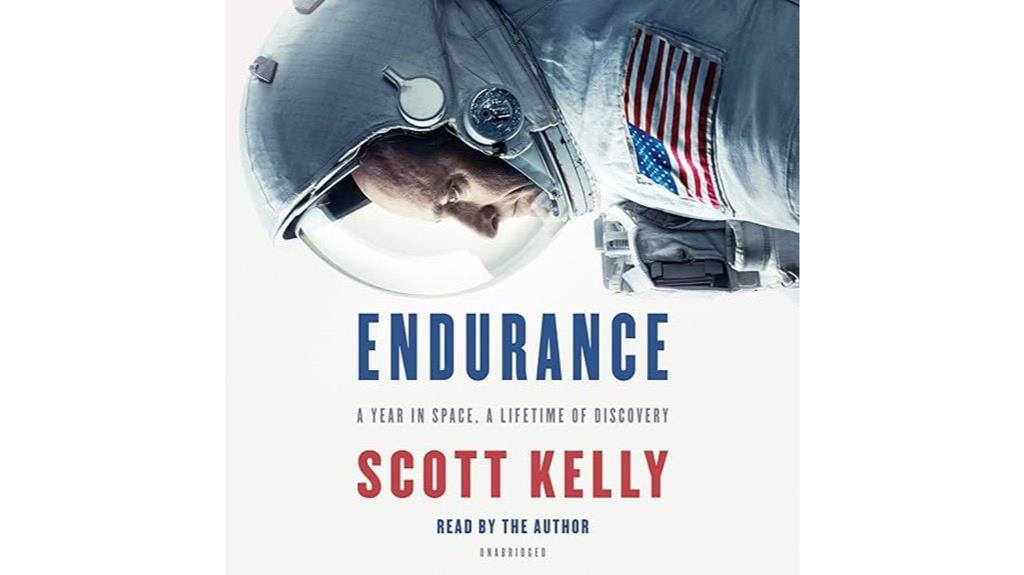
Those interested in inspiring stories of perseverance and scientific discovery will find “Endurance: A Year in Space, a Lifetime of Discovery” an excellent choice among the 8 Best Space Exploration Biographies. Scott Kelly’s journey from struggling student to astronaut is remarkable, fueled by his curiosity and resilience. His 340-day mission on the ISS revealed the physical and mental challenges of space travel, including effects on vision, DNA, and health. Kelly’s detailed account of rigorous training, international collaboration, and groundbreaking experiments offers a compelling look at the sacrifices and discoveries that shape humanity’s future in space. His story inspires us to push boundaries and embrace exploration.
Best For: readers interested in inspiring stories of perseverance, space exploration, and scientific discovery, especially those seeking motivation from real-life achievements.
Pros:
- Offers an in-depth, personal look at Scott Kelly’s extraordinary space journey and challenges faced.
- Highlights groundbreaking scientific research and international collaboration in space exploration.
- Combines engaging anecdotes, emotional reflections, and educational insights that motivate and inform.
Cons:
- May contain technical details that could be complex for casual readers unfamiliar with space science.
- Focuses primarily on Kelly’s experiences, which might not appeal to those seeking broader space history.
- The detailed account of experiments and training may be dense for readers looking for a quick overview.
Space Shuttle Stories: Firsthand Astronaut Accounts from All 135 Missions
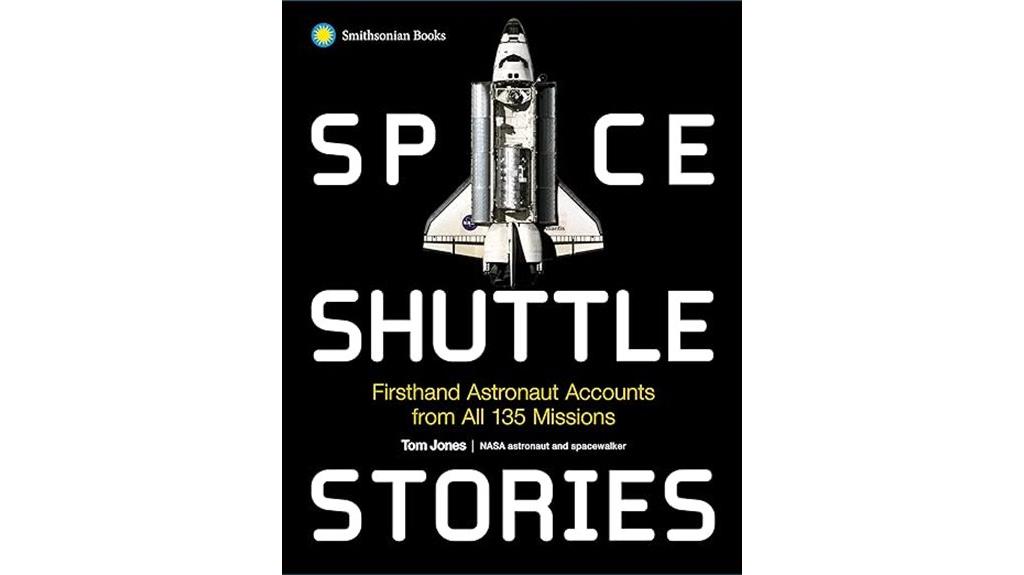
Are you enthusiastic to experience the human side of space exploration through vivid firsthand accounts? “Space Shuttle Stories” by Tom Jones is the perfect choice for anyone interested in detailed, personal narratives from all 135 shuttle missions. This book combines stunning images—like Atlantis on its booster and Earth from space—with authentic crew stories. It shares triumphs, tragedies, and personal reflections, capturing the excitement, fear, camaraderie, and wonder of spaceflight. From iconic missions with John Glenn to moments of heroism and vulnerability, it offers an engaging, accessible look into the human spirit behind NASA’s remarkable journey into space.
Best For: space enthusiasts, students, and anyone fascinated by the human stories behind space exploration who want an engaging, visually rich account of all 135 Space Shuttle missions.
Pros:
- Features extensive personal astronaut stories and firsthand accounts that bring missions to life.
- Includes stunning imagery and accessible mission summaries suitable for a wide audience.
- Celebrates the human spirit of exploration, inspiring hope and curiosity worldwide.
Cons:
- Packaging and presentation quality have minor issues, such as possible durability concerns.
- Some readers may find the large format less portable for casual reading.
- The book’s focus on storytelling may lack in-depth technical details for advanced space enthusiasts.
Failure Is Not an Option Book

Failure Is Not an Option by Gene Kranz is an essential read for anyone interested in leadership, teamwork, and the human side of space exploration. I was captivated by how Kranz recounts NASA’s missions from Mercury to Apollo 13, highlighting the critical decisions and teamwork that made success possible. His stories reveal the intense pressure, close calls, and heroism behind historic achievements. I appreciated his focus on resilience, trust, and the sacrifices made by controllers, astronauts, and support staff. The book also reflects on the decline of America’s pioneering spirit post-1960s, inspiring a renewed appreciation for exploration’s importance and the perseverance required to reach beyond our limits.
Best For: individuals interested in leadership, team dynamics, space history, and inspiring stories of perseverance and human achievement.
Pros:
- Offers detailed, behind-the-scenes insights into NASA’s space missions and decision-making processes.
- Emphasizes leadership principles, teamwork, resilience, and the human element behind technological success.
- Engaging storytelling that combines technical details with emotional and personal reflections, making complex topics accessible.
Cons:
- Some readers may find Kranz’s concise, story-focused style lacking in in-depth technical or historical analysis.
- The book primarily reflects the American space program, which may limit perspective for those interested in global space efforts.
- Limited discussion on the scientific and technological advancements outside of mission control and leadership aspects.
An Astronauts Guide to Life on Earth: Lessons on Ingenuity and Preparedness

If you’re looking for a biography that combines inspiring personal stories with practical lessons on resilience and ingenuity, “An Astronaut’s Guide to Life on Earth” by Chris Hadfield is an excellent choice. I found Hadfield’s insights on humility, perseverance, and teamwork truly motivating. His stories from space, like managing daily routines in zero gravity or engaging with the public through social media, highlight the importance of preparation and continuous learning. The book emphasizes effort over outcome and encourages embracing challenges with discipline and resilience. Reading it inspired me to pursue my own goals, reminding me that success comes from dedication, humility, and a growth mindset.
Best For: readers interested in personal development, resilience, and inspiring stories from space exploration that motivate self-improvement and lifelong learning.
Pros:
- Combines personal anecdotes with practical lessons on perseverance and humility
- Offers engaging insights into space life and astronaut training, making complex topics accessible
- Inspires readers to pursue their goals with a growth mindset and resilience
Cons:
- Some readers may find the technical details of space missions less engaging
- The focus on space and astronaut experiences might feel niche for those not interested in science
- Personal stories and lessons may seem repetitive or overly idealistic to some audiences
First Man: The Life of Neil A. Armstrong
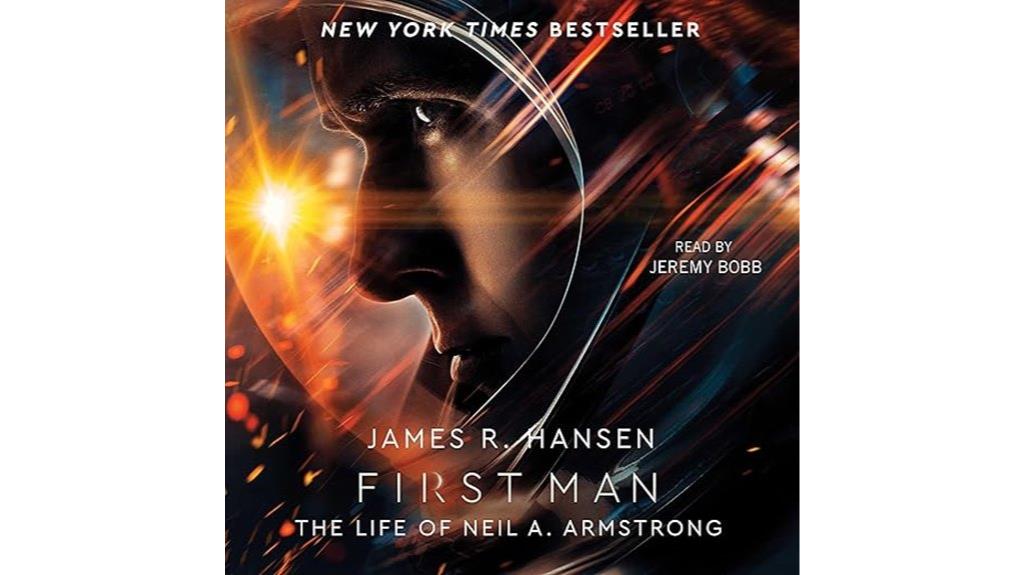
For readers enthusiastic to understand the person behind the historic moon landing, *First Man: The Life of Neil A. Armstrong* offers a compelling portrait. I learned that Neil’s childhood fascination with flying and engineering shaped his calm, focused personality. His bravery as a fighter pilot and test pilot built his technical expertise and resilience. Despite personal tragedy, he remained dedicated, exemplified by leading Apollo 11’s historic mission. Neil’s humility and meticulousness made him a natural leader, quietly inspiring millions. This biography reveals how his unwavering discipline, problem-solving skills, and genuine kindness propelled humanity’s greatest achievement and left a lasting legacy in space exploration.
Best For: readers interested in a detailed, inspiring biography of Neil Armstrong that highlights his character, technical expertise, and role in space history.
Pros:
- Provides an in-depth, comprehensive account of Neil Armstrong’s life and achievements.
- Highlights his personal traits of humility, discipline, and resilience that contributed to his success.
- Offers insights into the technical challenges and human stories behind the Apollo 11 mission.
Cons:
- May be too detailed for readers seeking a quick overview of Neil Armstrong’s life.
- Focuses heavily on the technical and historical aspects, possibly less engaging for casual readers.
- Some personal anecdotes or emotional stories may be limited, emphasizing factual accuracy over narrative flair.
Spaceman: An Astronaut’s Journey to Unlock the Secrets of the Universe
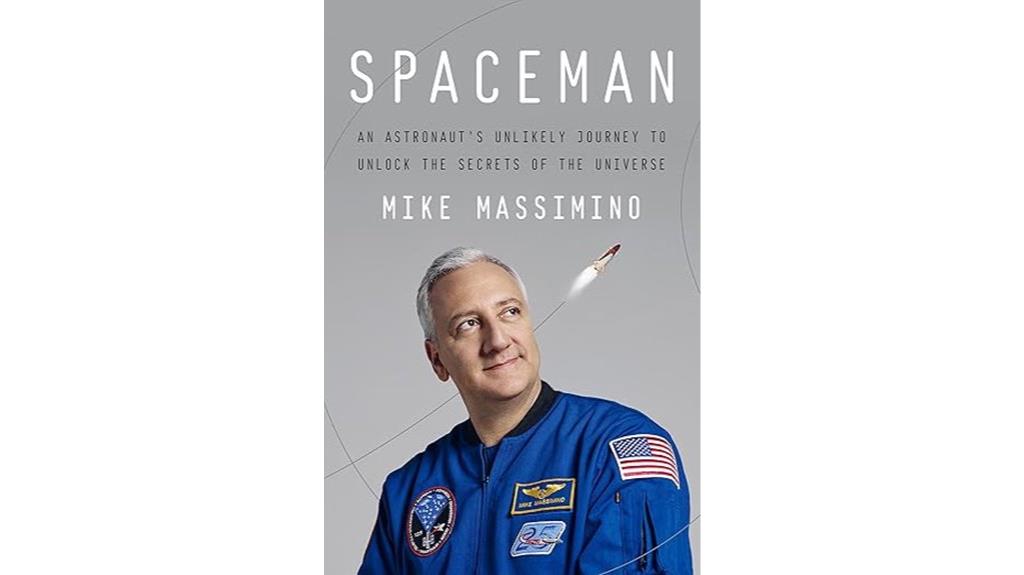
Are you looking for an inspiring biography that combines personal perseverance with a behind-the-scenes look at space missions? “Spaceman: An Astronaut’s Journey to Uncover the Secrets of the Universe” is perfect for readers enthusiastic to understand what it takes to become an astronaut and the human stories behind space exploration. I share how Mike Massimino’s unwavering dedication, resilience through multiple rejection, and genuine humility led him to service on critical Hubble missions. His vivid descriptions of spacewalks, teamwork, and technical challenges make you feel like you’re right there with him. This book reminds us that persistence and passion can turn dreams into reality.
Best For: readers interested in inspiring stories of perseverance, space exploration enthusiasts, and those wanting an engaging look behind the scenes of astronaut missions.
Pros:
- Vivid, engaging storytelling that immerses readers in spacewalks and mission experiences
- Offers valuable lessons on resilience, teamwork, and maintaining a positive attitude
- Combines technical insights with personal anecdotes, making complex topics accessible and entertaining
Cons:
- Some readers may find the detailed technical descriptions overwhelming or less engaging
- The focus on Mike Massimino’s specific experiences may not appeal to those seeking broader space history
- As an autobiography, it emphasizes personal perspective, which might limit coverage of other space missions or viewpoints
Never Panic Early: An Apollo 13 Astronauts Journey
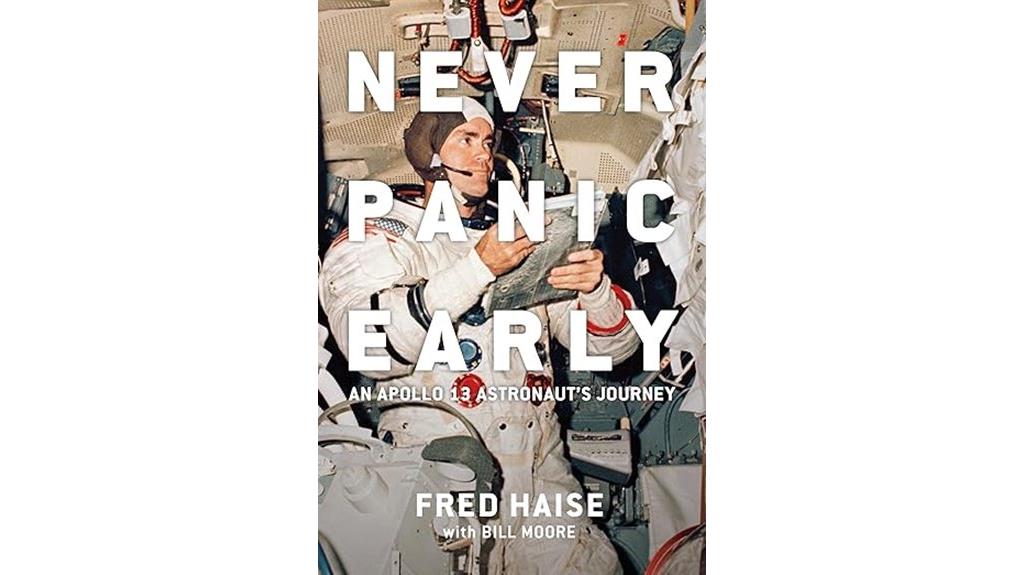
Anyone fascinated by astronauts’ firsthand accounts of crisis management and resilience will find “Never Panic Early: An Apollo 13 Astronauts Journey” an essential read. Fred Haise shares his incredible experience during the Apollo 13 mission, revealing how calmness and quick thinking kept him and his crewmates alive after the explosion. His storytelling is fast-paced and engaging, blending technical details with personal insights. Haise’s reflections on leadership, teamwork, and overcoming severe challenges inspire us all. The book offers a rare behind-the-scenes look at space mission adversity, emphasizing the importance of staying composed under pressure—lessons relevant both in space and in everyday life.
Best For: space enthusiasts, aerospace professionals, and anyone interested in leadership and resilience stories from the perspective of an Apollo astronaut.
Pros:
- Engaging and fast-paced storytelling that combines technical details with personal anecdotes
- Provides a unique behind-the-scenes look at the Apollo 13 crisis and astronaut camaraderie
- Inspires with lessons on resilience, leadership, and staying calm under pressure
Cons:
- Some readers find the narrative somewhat superficial with limited depth on certain topics
- Lacks extensive personal reflection on family life and broader career details
- Occasional abrupt topic shifts can disrupt the flow of the story
Factors to Consider When Choosing Space Exploration Biographies

When choosing a space exploration biography, I look at the author’s credibility to guarantee accurate information. I also consider whether the book connects with me personally and if its narrative style keeps me engaged. Finally, I pay attention to the level of technical detail and how well it places the story within its broader historical context.
Author Credibility
Choosing a credible space exploration biography hinges on evaluating the author’s background and expertise. I look for authors with solid professional credentials—such as advanced degrees, extensive research, or direct experience in aerospace science, engineering, or astronaut training. When authors have participated in space missions or worked with space agencies, their accounts tend to be more authentic and technically accurate. Peer-reviewed publications, awards, and recognition in space science further signal reliability. I also check for detailed, verifiable technical information and consistent factual accuracy throughout the book. An author’s credibility guarantees the biography is trustworthy, providing me with a true understanding of space exploration and inspiring confidence in the stories shared.
Personal Connection
A strong personal connection to a space exploration biography often makes the story more engaging and meaningful. When I choose a biography that resonates with my own background, motivations, or struggles, I feel more immersed in the subject’s journey. Stories that include personal anecdotes, emotional moments, or reflections help me connect on a deeper level. I appreciate when authors share vulnerabilities, doubts, or sacrifices, making these figures feel human rather than distant icons. This relatability fuels my inspiration, resilience, and sense of possibility for my own pursuits. Ultimately, selecting a biography that mirrors my values or experiences transforms reading from mere information to a powerful, motivating encounter that encourages me to dream bigger and push boundaries.
Narrative Style
The way a space exploration biography is written can considerably impact how I connect with the story. A compelling narrative uses storytelling techniques that blend technical details with personal anecdotes, making complex missions relatable. Vivid descriptions of mission experiences and astronauts’ reflections draw me into their human side and the challenges they faced. Using chronological storytelling helps me follow the sequence of events clearly, making intricate missions easier to understand. Incorporating direct quotes and firsthand accounts from astronauts adds authenticity and creates a conversational, immersive feel. Striking a balance between technical explanations and accessible language ensures I, whether an enthusiast or a casual reader, can enjoy and grasp the story without feeling overwhelmed. This engaging style keeps me invested and inspired.
Technical Detail Level
When selecting a space exploration biography, consider how much technical detail matches your familiarity with the subject. Some books are tailored for general audiences, emphasizing personal stories and mission highlights without overwhelming technical jargon. Others explore spacecraft systems, engineering challenges, and scientific experiments, often including diagrams or detailed data. If you’re new to space topics, a biography with simpler explanations will be more engaging and accessible. Conversely, if you’re an enthusiast or professional, a highly technical account with specifications, calculations, and telemetry details can deepen your understanding. The key is choosing a biography that aligns with your knowledge level, ensuring you’re neither bored nor lost in complexity. Balancing technical depth with readability makes your reading experience both inspiring and comprehensible.
Broader Historical Context
Understanding the broader historical context of space exploration helps us appreciate how geopolitical tensions, technological advances, and societal attitudes shaped the stories of the pioneers involved. The Cold War rivalry between the U.S. and the Soviet Union fueled intense competition, driving rapid progress from Sputnik’s launch in 1957 to the Apollo moon landings. This era of the space race became a symbol of national pride and technological prowess. After Apollo, shifting political priorities, funding cuts, and waning public interest led to a slowdown in manned missions. Instead, international collaborations like the ISS emerged. Recognizing this history helps us see how space biographies reflect not only individual achievement but also the complex interplay of politics, innovation, and societal values that fueled humanity’s quest to explore beyond Earth.
Frequently Asked Questions
Which Biographies Are Best Suited for Young Readers Interested in Space?
If you’re looking for space exploration biographies for young readers, I recommend “Hidden Figures” by Margot Lee Shetterly, which tells inspiring stories of African American women mathematicians at NASA. “The Astronaut Handbook” by Meghan McCarthy is also fantastic, offering a fun, engaging look at what it takes to become an astronaut. These books ignite curiosity and passion for space, making them perfect for young aspiring astronomers.
How Do Biographies Influence Future Generations of Astronomers and Scientists?
You might think biographies just tell stories, but honestly, they shape the future of astronomers and scientists. I’ve seen how reading about pioneers ignites curiosity, sparks dreams, and fuels perseverance. Ironically, it’s these stories of struggle and discovery that inspire the next generation to reach for the stars, proving that a good biography isn’t just history—it’s a blueprint for innovation and exploration.
Are There Biographies Focusing on Women Pioneers in Space Exploration?
Yes, there are biographies highlighting women pioneers in space exploration. I’ve read inspiring stories about women like Valentina Tereshkova, the first woman in space, and Sally Ride, the first American woman in space. These books showcase their struggles and achievements, motivating future generations of women in STEM. I believe these biographies play a crucial role in breaking barriers and encouraging young girls to pursue careers in space science and exploration.
What Are the Common Themes Across Influential Space Exploration Biographies?
I find that influential space exploration biographies often share themes of curiosity, resilience, and daring. When I read about pioneers pushing boundaries despite setbacks, it reminds me how passion and perseverance drive progress. These stories reveal that breakthroughs come from relentless pursuit, embracing failure as part of growth. They inspire me to stay curious, dream big, and keep exploring—knowing that even small steps can lead to cosmic discoveries.
How Can These Biographies Enhance STEM Education and Outreach Efforts?
These biographies can truly boost STEM education and outreach by inspiring curiosity and passion. I share stories of perseverance, discovery, and innovation that resonate with students and educators alike. They make complex science accessible and exciting, encouraging young minds to pursue careers in space and science. By highlighting real-world challenges and achievements, I believe these stories motivate future astronomers and scientists to dream big and push boundaries.
Conclusion
If you’re inspired by the cosmos, these biographies will ignite your passion and curiosity. Did you know that over 600 astronauts have flown to space since Yuri Gagarin’s historic 1961 mission? That’s a small but incredible club of explorers pushing the boundaries of human achievement. Plunge into these stories, and you’ll find lessons of resilience, ingenuity, and wonder that can fuel your own dreams—because the universe belongs to those who dare to explore.






